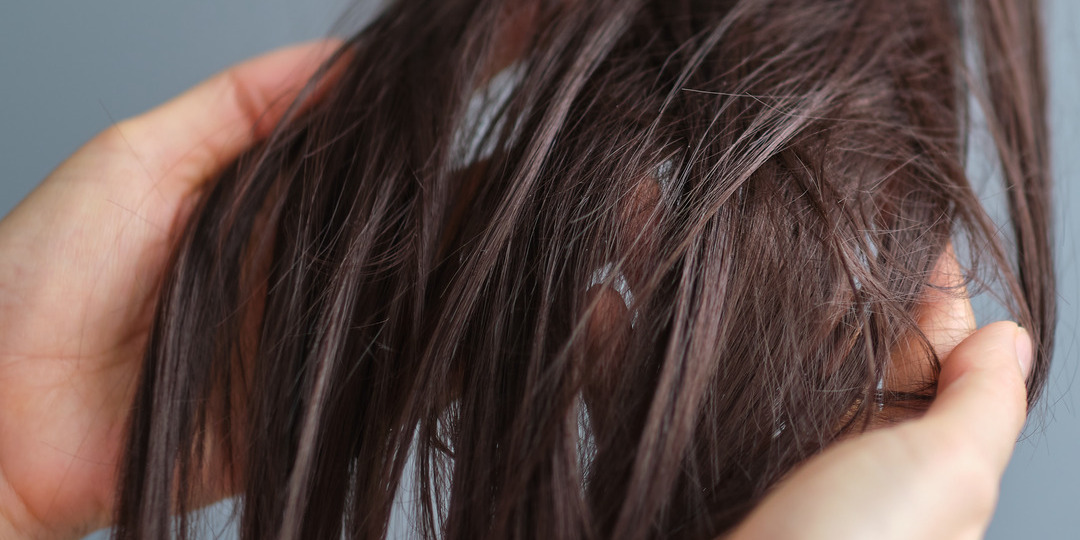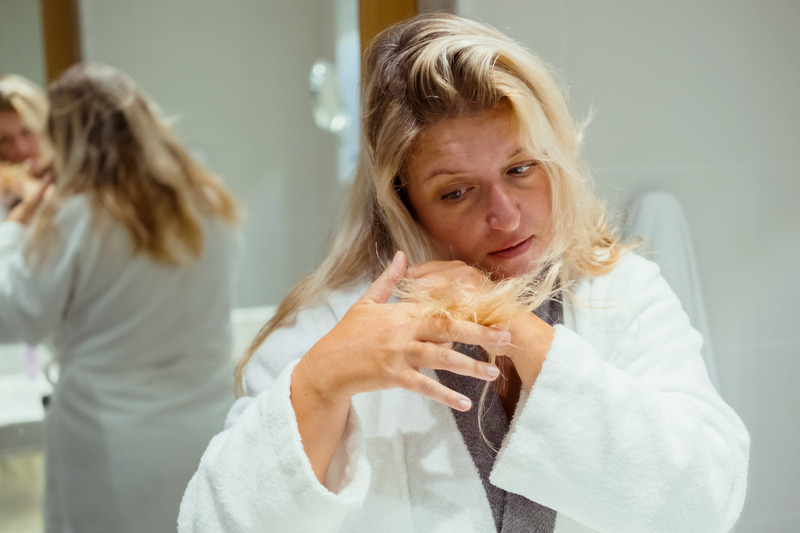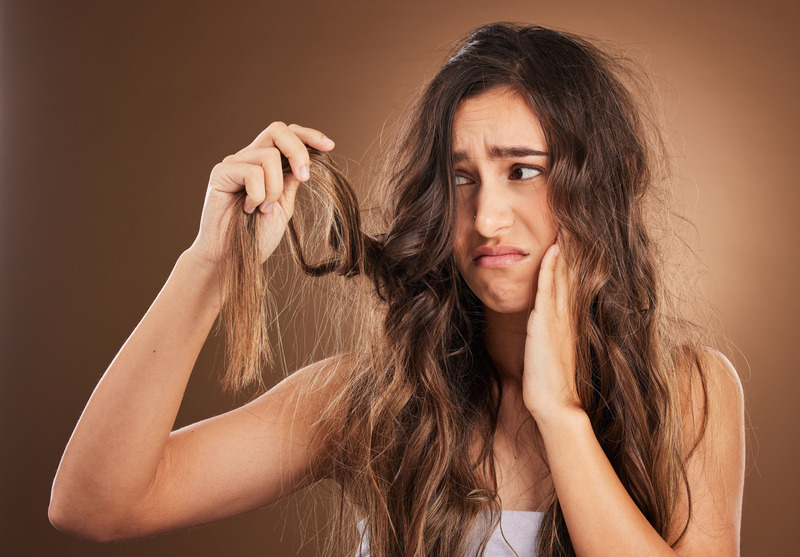
Many individuals have incorporated heat-styling tools such as blow dryers, flat irons, and curlers into their daily routines. However, it is essential to be aware that excessive heat can cause damage to your hair strands.
Let’s explore the various signs of heat damage, tips, and methods for reviving and repairing heat-damaged hair so that you can restore your hair’s health and vitality.
What is Heat Damage?
Heat damage occurs when excessive heat alters the inherent structure of the hair shaft. Hair is predominantly made up of proteins, specifically keratin.
When exposed to elevated temperatures, these proteins deteriorate, losing hair’s natural curl, shine, and moisture and future result in hair shaft damage.
How Does Heat Damage Hair?
Each hair strand essentially consists of three primary components:
- Medulla- The innermost layer of hair consists of round cells. It is typically present in thick or coarse hair, whereas fine or light blonde hair usually lacks it.
- Cortex- The cortex, which constitutes over 90% of our hair, contains melanin pigments determining its color, but the cortex is not completely exposed. Composed of keratin proteins and structural lipids, it also ensures the hair’s strength and elasticity.
- Cuticle- The outer hair layer protects and adds shine. It’s the hair health only visible layer.
Heat alters the structure of keratin proteins in the hair follicles, leading to damage. By converting a-keratin to -keratin, it weakens the protective cuticle layer and causes dehydration.
Over time, it weakens the hair, reducing elasticity and increasing vulnerability to damage. Hair typically avoids high temperatures when left alone, but exposure to heat can cause damage.
Common heat tools and outdoor conditions can impact your hair:
- Blow dryers
- Curling iron
- High UV light (sunlight) exposure
- Flat irons
7 Common Signs of Heat-Damaged Hair

Heat can leave your hair dull and damaged, with split ends and a lifeless appearance. If you’re wondering what heat-damaged hair looks like, it’s a trail of visible harm from using heat tools, such as curling sessions.
Preserve the freshness and health of your hair by being mindful of heat styling. Signs to watch out for:
Split ends and breakage
Excessive heat can cause the hair cuticles to disintegrate, resulting in the degradation of hair strands’ precious keratin. As a consequence, your hair becomes weak and susceptible to damage.
This can manifest as an increase in split ends and hair breakage, both of which are common indicators of heat damage.
Unmanageable hair
Natural hair damaged by heat tends to have a stiffer texture and becomes more challenging to style. Daily wear and tear can also contribute to your hair’s more unruly and dry appearance.
Tangles and knots
Heat and sun damage often leads to broken, frizzy, and scraggly ends in hair. When hair loses its natural shine and elasticity, it tends to clump and become tangled, creating a messy appearance.
Dull hair
Fried hair appears lackluster and lifeless. This occurs because damaged hair fibers scatter light instead of reflecting it, resulting in a faded and dull appearance.
Changed color
Hair pigment, whether dyed or natural, can oxidize and fade when exposed to high temperatures and heat. Take a moment to assess if your hair color has noticeably changed after using heat regularly.
Furthermore, look for small white nodules at the ends of your hair, as they indicate irreversible damage caused by intense heat. These white dots result from hair proteins being rapidly and intensely deformed by high heat alone.
High porosity
This aspect might be a bit more challenging to observe. However, you may notice higher hair cuticle porosity following a shower. Heat damage causes the hair cuticles to become more porous, allowing for increased moisture absorption.
Conversely, high porosity can result in the hair cuticle being unable to retain moisture more quickly, which can lead to frizz.
Hair feels rough texture
Heat damage can lead to tangled knots, limp strands, and a dehydrated texture, often caused by moisture depletion. Additionally, elevated temperatures can potentially disrupt the natural curl pattern of hair.
A study revealed that consistent use of a flat iron hindered the restoration of the hair’s original curl texture, even after washing.
Repairing Heat-Damaged Hair: Natural Home Remedies

The global hair industry is worth billions. It’s no surprise that countless hair cosmetics claim to fix damaged hair.
But before you load up on shampoos, sprays, serums, creams, and gels, try these natural remedies for heat-damaged hair.
Try An Oil Soak
An oil soak is a great way to revive and nourish your hair, restoring its natural shine and strength. You can effectively treat dry and damaged hair by choosing suitable oils, like coconut oil, Ucuuba butter, and olive oil.
Make this part of your hair care routine to enhance your locks’ health and vitality. Sunflower oil and mineral oils provide only a superficial coating to your hair, lacking the ability to penetrate and provide any real benefits.
To keep your scalp moisturized, treat it with oil using these steps:
- Gently massage your scalp with a high-quality plant-based oil for approximately 15 to 20 minutes.
- Wrap your oiled hair with a towel or a soft cotton cloth soaked in hot water for better results.
- Allow it to remain on your hair for one hour prior to rinsing with a gentle shampoo and conditioner.
The steam generated by the heated oil opens up the cuticles of your hair, facilitating deep penetration of the nourishing oils. As a result, your hair is left thoroughly nourished, benefiting from this process.
Use Natural Shampoo
Most shampoos contain harmful chemicals like Sodium Lauryl Sulfate (SLS), formaldehyde, parabens, and synthetic fragrances that can worsen hair damage. Opt for a natural shampoo without these ingredients and instead look for ones with silica or biotin.
Biotin promotes healthy hair growth and enhances hair health. You can even create your own natural shampoo using just a few simple ingredients, such as:
- 1/2 liquid castile soap
- 1/2 cup distilled water
- 1/2 cup aloe vera gel
- 10-12 drops of vitamin E oil
- Two (2) teaspoons of vegetable glycerin
- A few drops of your preferred essential oils
How To:
- Combine all the ingredients in a bottle and shake vigorously to ensure thorough mixing.
- Gently massage a small amount, equivalent to the size of a dime, into your hair and allow it to remain for a few minutes.
- Rinse off with cool water.
Use A Hair Mask
Hair masks are a convenient way to soothe, nourish, and heal your hair. Plus, you can easily create them using ingredients found in your pantry.
Try these super nourishing hair masks to repair any hair damage:
Banana and olive Oil
Transform your heat-damaged hair into silky smoothness with this homemade hair restoration mask:
- Take a ripe banana and mash it gently.
- Add approximately 8 to 10 drops of pure almond oil to the mixture.
- Combine these ingredients and gently massage the mixture into your hair.
- Leave on for 15-20 minutes, then rinse off with a mild shampoo
Egg and Yoghurt
Eggs are a protein-rich food, providing the essential building blocks for healthy hair. On the other hand, yogurt is a source of milk fat that contains a generous dose of lactic acid.
Combining these two ingredients can work wonders in revitalizing dry and damaged hair. Create your own hair mask using eggs and yogurt with these easy steps:
- Combine two eggs with half a cup of yogurt and whisk them together.
- Put the mask evenly on your hair and scalp for maximum effectiveness.
- Allow it to soak for a duration of 20 to 30 minutes.
- Use a mild shampoo to wash your hair and cool water, ensuring to avoid using warm or hot water as it may cause the eggs to cook.
Avocado And Olive Oil
This do-it-yourself hair mask provides a well-deserved shine to the ends of your hair exposed to heat, leaving them with a noticeably healthier appearance.
- Mash up half of an avocado.
- Combine it with half a cup of olive oil.
- Gently massage the mixture onto your hair and scalp, ensuring thorough coverage.
- Allow it to rest for 20-30 minutes before rinsing off using a gentle shampoo.
Honey And Oil
Are you looking to restore your heat-damaged hair without resorting to a trim? Look no further than honey!
Packed with antioxidants, nutrients, and the all-important protective proteins known as keratin, honey is the natural solution you’ve been searching for. Enhance your hair care routine with this nourishing honey-based solution, perfect for repairing heat damage:
- Mix honey with natural oils like olive, coconut, milk, or apple cider vinegar.
- Pour the solution into a spray bottle.
- Mist it on your hair and spread it evenly with your fingers.
- Wash off after 20-30 minutes for best results.
- Rub In Some Epsom Salt
Magnesium sulfate, also known as Epsom salt, is beneficial for treating splinters and cracks and can be used to enhance hair and scalp health. While research is still limited, Epsom salt is believed to act as a hair activator for heat-damaged curly hair.
Here’s a guide to using Epsom salt for damaged, dry, and brittle hair:
- Put a coin-sized amount of conditioner in a bowl.
- Add an equal amount of Epsom salt. Warm the mixture to ensure thorough mixing.
- After shampooing, use your fingertips to work this mixture into your roots and scalps.
- Leave it on for about 20 minutes before rinsing it off.
- If you have oily hair, use Epsom salt in your shampoo instead of conditioner.
- Use this solution to lather your hair and rinse thoroughly for clean and refreshed locks.
- Rinse Your Hair With Tea
If blow dryers and heating tools are causing excessive hair shedding, try rinsing your hair overnight with tea as a potential solution. Try this tea hair rinse for strong, shiny, and healthy hair:
- Boil tea leaves in water and let steep for 30 minutes.
- Gently cleansing it with shampoo, leaving it refreshed and revitalized.
- Gently mist your hair with the rinse when it is still slightly damp.
- Wrap it in a soft towel and leave for 15-20 minutes.
- Rinse your hair using cold water.
Take Note: Green tea, peppermint tea, chamomile tea, rosemary tea, black tea, and hibiscus tea leaves are all excellent choices for a nourishing hair rinse.
Use A Cool-Mist Humidifier
Investing in a cool mist humidifier can fix heat-damaged hair by maintaining moisture in the air. This prevents excessive drying, especially during harsh winter months.
By preventing heat damage, you can keep your locks looking healthy and avoid needing home remedies to fix dry and damaged hair.
Restoring Heat Damaged Hair: Essential Steps for Recovery

Protect Your Hair with Heat Protectant to Shield it from damage.
Use a heat protectant to safeguard your hair during hot tool styling or during chemical treatments. These products, like sunscreen, reduce damage from blow-drying, straightening, and curling.
Utilize both warm and cold water.
Use warm water to wash your hair and cold water to lock in moisture and nutrients from the conditioner. Avoid hot water, as it can damage and dehydrate your hair.
Reduce Heat Treatment
Ditch the blow dryer! Let your hair air-dry or gently towel-dry with a microfiber towel. Avoid rubbing vigorously.
If blow-drying is necessary, opt for the cool blast setting.
Schedule a Maintenance Trim for Your Hair
Regular trims every 3-4 months help maintain smooth hair and prevent split ends from causing further damage.
Focus on Shampooing and Conditioning
Always prioritize shampooing your scalp and conditioning your ends. Shampoo is designed to cleanse the scalp by removing dirt, sebum, and product build-up.
You don’t need to shampoo your entire head. On the other hand, your scalp doesn’t require conditioner, but your ends do!
Protect Your Hair From The Elements
Use an umbrella or hat when you go outside. If you let your hair fly, the wind and sun will dry it out and make it dirty, damaging your hair.
Avoid Combing Wet Hair
To protect your hair from damage, avoid combing it when wet. Wet combing increases the risk of breakage.
Instead, try detangling your hair with your fingers in the shower to prevent breakage and pulling when it’s dry.
Invest in Leave-in Conditioners for Your Haircare Routine
A high-quality leave-in conditioner for thin and thick hair prevents dryness and frizz, while hair serum effectively moisturizes and repairs damage caused by flat irons.
Take Note: Aim the hair dryer nozzle downwards when drying your hair and keep it 15-25 cm away from damp hair to avoid excessive heat exposure.
Bottom Line
Although the temptation of flawlessly styled hair is hard to resist, it’s crucial to prioritize long-term healthy locks. By recognizing the signs of heat damage and implementing protective measures, we can enjoy versatile hairstyles without compromising the overall health of our hair.
Remember that we can restore our precious tresses’ bounce, shine, and vitality with proper care and attention.
Looking for hair care products? Check out Vitamins Revive for all your hair needs! Vitamins Revive is a well-known brand in the hair care industry, offering a wide range of products designed to nourish and revitalize your hair.
Whether you’re looking to repair damaged hair, promote growth, or simply maintain healthy locks, Vitamins Revive likely has something to offer. Shop their selection of shampoos, conditioners, masks, and other products to restore your hair’s natural beauty.
FAQ’s
How to treat heat-damaged hair?
To repair heat-damaged hair, adjust your heat styling routine. Get an excellent flat iron with temperature control, apply a thermal heat protectant, and ensure your hair is dehydrated before using heat.
Regular hydration and hair trims are also essential.
How long does it take to repair damaged hair?
Hair damage is irreversible once protein bonds and cuticles are altered by heat. Revive your hair by hydrating it with natural and nourishing products, growing it out, and regularly trimming it.
Invest in a high-quality heat styling tool to prevent further damage.
Is it OK to use hot tools on the hair once a week?
Although it is possible to use heat on your hair once a week, it is advisable to exercise caution and minimize excessive heat exposure or that it has heat protectants to safeguard the health and beauty of your precious locks and prevent future heat damage.
How long does heat damage last?
The effects of heat damage on hair vary based on severity. Severe hair damage may require cutting to prevent permanent harm.
But with consistent care and suitable products, heat damage can be fully repaired within a year.










